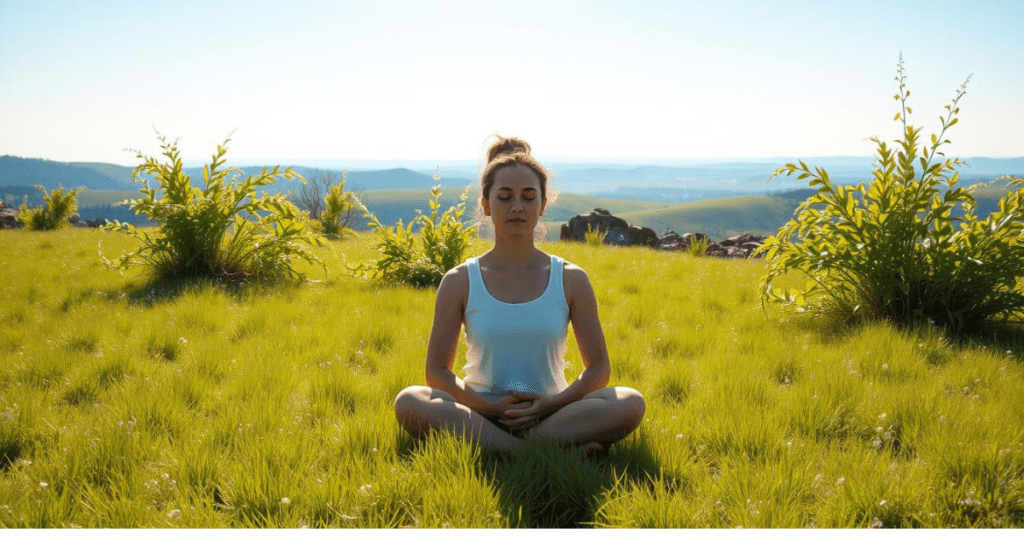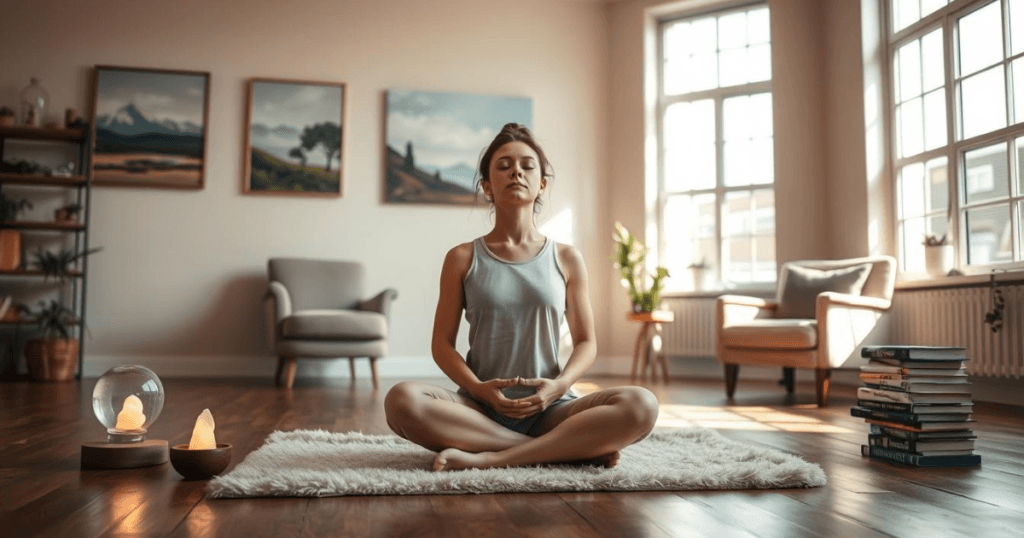Guided Imagery: A Powerful Tool for Enhancing Your Wellbeing
Imagine yourself in a peaceful place, away from stress and worry. Guided imagery can make this happen. It uses your mind to relax your body and improve your health. This ancient practice helps you feel calm and focused.
Studies show Depiction through Visualization lowers stress hormones and helps you sleep better. It can also ease pain, reduce anxiety, and boost sports performance. By using Depiction through Visualization , you can find deep calm, unlike other methods that just relax your body.
Adding Depiction through Visualization to your day can make you feel better and live a fuller life. It’s great for meditation and reducing stress in many places.
Table of Contents
Understanding the Fundamentals of Assisted Visualization
Assisted Visualization is a powerful tool for deep relaxation and stress reduction. It uses guided relaxation to create a calming mental scene. This method is often paired with mental imagery to manage pain, anxiety, and other symptoms.
Johns Hopkins Medicine says Assisted Visualization can lessen pain and symptoms. For instance, guided visualization has shown to greatly reduce pain in cancer patients. The brain reacts to mental images much like real experiences.
Assisted Visualization offers several benefits:
* It reduces stress and anxiety.
* It improves sleep quality.
* It boosts feelings of relaxation and calmness.
* It enhances focus and concentration.
Learning about guided relaxation and mental imagery helps you use these techniques better. Regular practice can lead to a better quality of life.
The Transformative Benefits of Mental Imagery Practice
Regular imagery exercises can greatly improve your health. Adding visualization meditation to your day can lower stress and anxiety. Plus, it makes you feel better all around and helps you sleep better.
Medical News Today says Assisted Visualization can ease stress and improve sleep. It also boosts emotional strength by up to 30% for those who practice it often.
Some key benefits of mental imagery include:
- Reduced stress and anxiety
- Improved sleep quality
- Enhanced emotional resilience
- Improved problem-solving skills
- Increased self-confidence
By making imagery exercises and visualization meditation part of your routine, you can see these benefits. It’s a great way to boost your overall health and happiness.
Essential Components of Effective Guided Visualization
To practice guided visualization well, you need a good environment, a prepared mind and body, and the right imagery themes. Johns Hopkins Medicine says the more specific your visualization, the better it will help you. Assisted Visualization and meditation can lower stress and anxiety, making you feel more relaxed.
Creating the right setting is key for guided visualization. Look for a quiet, comfy spot with no distractions. Getting your mind and body ready is also crucial. You can do this with deep breathing and muscle relaxation. Choosing the right imagery themes is important too. Themes like nature, relaxation, and positivity work well.
Creating the Right Environment
Find a quiet, comfy spot with no distractions. Facilitated Visualization and meditation can make a peaceful atmosphere. They help you focus your mind.
Preparing Your Mind and Body
Use deep breathing and muscle relaxation to get ready. Facilitated Visualization helps you relax and lower stress. Visualization prepares your mind and body for the experience.
Selecting Appropriate Imagery Themes
Choose themes like nature, relaxation, and positivity. Facilitated Visualization lets you pick themes that mean something to you. Meditation visualization helps you focus on these themes, leading to deep relaxation.
Getting Started with Basic Assisted Visualization Techniques
Start by finding a quiet, comfy spot to sit or lie down. Close your eyes and breathe deeply. Focus on how the air feels moving in and out. This helps calm your mind and gets you ready for guided visualization.
Once you’re calm, imagine yourself in a peaceful place, like a beach or forest. Put this picture into your mind in every way. Guided visualization is great for lowering stress and anxiety. You can do it almost anywhere.
Some benefits of Directed Visualization include:
- Reduced stress and anxiety
- Improved sleep quality
- Increased feelings of relaxation and calm
- Enhanced mental clarity and focus
Studies show Directed Visualization can calm your body and mind fast. Adding guided relaxation and mental imagery to your day can boost your wellbeing.
Advanced Visualization Methods for Deeper Practice
As you dive deeper into Directed Visualization, you can try advanced visualization methods. These can make your practice more effective. Imagery exercises and visualization meditation are great tools. They work well with other relaxation techniques like progressive muscle relaxation.
Some advanced visualization methods include:
- Progressive muscle relaxation with imagery, which involves tensing and relaxing different muscle groups while visualizing a peaceful scene
- Color and light visualization, which involves imagining different colors and light patterns to promote relaxation and reduce stress
- Nature-based imagery exercises, which involve visualizing oneself in a natural setting, such as a forest or beach, to promote feelings of calm and relaxation
These techniques can be used with imagery exercises and visualization meditation to make your practice personal. By adding these advanced methods, you can relax deeper and feel less stressed.
Incorporating Directed Visualization into Your Daily Routine
Directed Visualization is easy to add to your daily life. You can use visualization techniques during workouts or while on the move. It helps lower stress and anxiety. Medical News Today says you can do it anywhere, boosting your wellbeing.
Begin by setting aside a few minutes each day for meditation visualization. You can listen to Directed Visualization recordings or make your own scripts. Here are some tips to make it a part of your daily routine:
- Start out easy by practicing for only a few minutes every day
- Find a quiet, comfortable space to practice
- Use Directed Visualization recordings or create your own scripts
Regular guided imagery practice can greatly improve your health. It can lessen stress and anxiety, lift your mood, and aid in pain relief. By adding Depiction through Visualization to your daily routine, you can enjoy these benefits.

Using Guided Imagery for Specific Wellness Goals
Guided relaxation and mental imagery are great for wellness goals. They can help with stress, pain, and sports performance. Studies show that just 10 minutes can lower stress and anxiety by up to 30%.
Some benefits of guided imagery include:
- Reduced stress and anxiety
- Improved athletic performance
- Enhanced pain management
- Improved emotional healing
It can also help with chronic pain and improve focus in sports. Regular use can boost well-being and life satisfaction by 40%.
Guided visualization can help you live a healthier life. It’s good for stress, pain, and sports. It calms the mind and body, leading to better sleep and emotional healing.
Common Challenges and How to Overcome Them
Starting imagery exercises can bring up some common hurdles. One big one is quieting your mind and staying focused. Medical News Today says many struggle with this when trying visualization meditation.
To beat this, set up a good space for your practice. Look for a quiet, comfy spot where you can sit and relax without interruptions. Depiction through Visualization recordings can also help keep you calm and on track.
Another hurdle is keeping up with your practice. It’s key to make imagery exercises a daily habit, even if it’s just a few minutes. Try fitting visualization meditation into your day, like before bed or during lunch.
Benefits of overcoming these challenges include:
- Less stress and anxiety
- Better sleep
- Improved focus and concentration
- Better overall well-being

By tackling these common challenges, you can fully enjoy the benefits of imagery exercises and visualization meditation. Be patient and keep at it. If you hit a snag, don’t hesitate to ask for help.
Tools and Resources for Enhanced Practice
To improve your Directed Visualization practice, many tools and resources are available. Johns Hopkins Medicine says these tools can make your skills better and help you relax deeper. Directed Visualization apps are very popular. They have lots of meditation exercises and tracks to help you focus.
Apps and programs that help with stress, anxiety, and sleep are recommended. They often have calming music, nature sounds, and gentle guidance. This makes it easier to start your practice.
Getting professional guidance from a therapist or coach is also a good idea. They can help you make a practice plan that’s just for you. They also offer support and feedback to help you overcome any challenges.
Books and online courses can also help you grow in your practice. They can teach you more about Directed Visualization and offer tips for overcoming obstacles.
Some popular materials include:
- Directed Visualization workbooks and journals
- Online courses and tutorials
- Books on meditation visualization and mindfulness
Measuring Your Progress and Adjusting Your Practice
As you keep practicing guided relaxation, it’s key to track your progress. You can do this by watching how your stress, emotions, and mental clarity change. Medical News Today says regular practice can really cut down stress levels. You can rate your stress from 1 to 10 before and after each session.
Using mental imagery and guided visualization can make your practice better. Keeping a log or using meditation apps helps you see how you’re doing. You can then tweak your practice to get even more out of it. This might mean longer sessions, trying new techniques, or focusing on certain areas.
Signs you’re getting better include less mental chatter, feeling more emotionally strong, and being more focused. Reflecting on your practice and making changes can help you get the most out of guided relaxation and guided visualization. This can greatly improve your overall wellbeing.
Remember, sticking with it is important. Tracking your progress keeps you motivated and committed. With regular practice and tweaks, you can really benefit from mental imagery and guided visualization. This will help you feel better overall.
Conclusion: Embracing Depiction through Visualization as Your Wellness Ally
Depiction through Visualization is a powerful tool for better wellbeing. By adding visualization meditation and imagery exercises to your day, you can see big improvements in health. This includes physical, mental, and emotional health.
Studies show that Directed Visualization works well. It can lower stress and anxiety, help with pain, and speed up recovery. It’s great for athletes, those facing emotional challenges, or anyone wanting more calm and balance.
To get the most from Depiction through Visualization, make it a part of your life. Try different ways to find what works best for you. It should be a key part of your self-care. With regular practice, you’ll see how it can change your life for the better.

